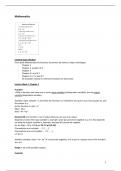Summary
Summary Mathematics for Pre-Master Mid-Term TISEM Tilburg University
- Course
- Institution
This is an extensive summary of the video lectures of each week (class notes) screens of important example questions discussed during the Q&A, and more examples. Studying this and practicing the old exams will guarantee that you pass the course! Good luck.
[Show more]



